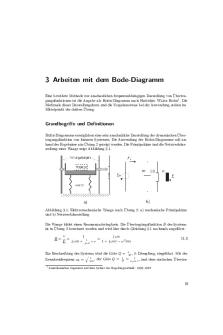Bode Rules - notes PDF

| Title | Bode Rules - notes |
|---|---|
| Course | Electrical engineering introduction |
| Institution | North-West University |
| Pages | 4 |
| File Size | 272.5 KB |
| File Type | |
| Total Downloads | 52 |
| Total Views | 137 |
Summary
notes...
Description
Rules for Making Bode Plots Term
Magnitude
Constant: K
Phase
20·log10(|K|) •
Real Pole:
1
•
s +1 ω0
• •
Low freq. asymptote at 0 dB High freq. asymptote at -20 dB/dec Connect asymptotic lines at ω0,
• • •
Real Zero : s + 1 ω0 *
Pole at Origin: 1 s
Zero at Origin*: s Underdamped Poles: 1 2
s s + 2ζ + 1 ω0 ω0 Underdamped Zeros*:
•
•
Low freq. asymptote at 0 dB High freq. asymptote at +20 dB/dec. Connect asymptotic lines at ω0.
•
-20 dB/dec; through 0 dB at ω=1.
•
-90° for all ω.
•
+20 dB/dec; through 0 dB at ω=1. Low freq. asymptote at 0 dB. High freq. asymptote at -40 dB/dec. Connect asymptotic lines at ω0. Draw peak† at freq. ω0, with amplitude H(jω0)=-20·log10(2ζ) Low freq. asymptote at 0 dB. High freq. asymptote at +40 dB/dec. Connect asymptotic lines at ω0. Draw dip† at freq. ω0, with amplitude H(jω0)=+20·log10(2ζ)
•
+90° for all ω. Low freq. asymptote at 0°. High freq. asymptote at -180°. Connect with straight line from ω=ω0·10-ζ to ω0·10ζ
• •
• • • •
• •
2
s s + 2ζ +1 ω 0 ω0
• •
•
• • •
• • •
•
Time Delay: e−sT
K>0: 0° K0.5 are too small to draw, and ignore them. However, for underdamped poles and zeros peaks exists for 0 n=[1 11 10]; >> d=[1 10 10000 0]; >> sys=tf(n,d) Transfer function: s^2 + 11 s + 10 ---------------------s^3 + 10 s^2 + 10000 s
%A numerator polynomial (arbitrary) %Denominator polynomial (arbitrary)
>> damp(d) Eigenvalue 0.00e+000 -5.00e+000 + 9.99e+001i -5.00e+000 - 9.99e+001i
%Find roots of den. If complex, show zeta, wn. Damping Freq. (rad/s) -1.00e+000 0.00e+000 5.00e-002 1.00e+002 5.00e-002 1.00e+002
>> damp(n) Eigenvalue -1.00e+000 -1.00e+001
%Repeat for numerator Freq. (rad/s) 1.00e+000 1.00e+001
>> >> >> >> >>
Damping 1.00e+000 1.00e+000
%Use Matlab to find frequency response (hard way). w=logspace(-2,4); %omega goes from 0.01 to 10000; fr=freqresp(sys,w); subplot(211); semilogx(w,20*log10(abs(fr(:)))); title('Mag response, dB') subplot(212); semilogx(w,angle(fr(:))*180/pi); title('Phase resp, degrees')
>> %Let Matlab do all of the work >> bode(sys) >> %Find Freq Resp at one freq. %Hard way >> fr=polyval(n,j*10)./polyval(d,j*10) fr = 0.0011 + 0.0010i >> %Find Freq Resp at one freq. >> fr=freqresp(sys,10) fr = 0.0011 + 0.0009i
%Easy way
>> abs(fr) ans = 0.0014 >> angle(fr)*180/pi ans = 38.7107
%Convert to degrees
>> %You can even find impulse and step response from transfer function. >> step(sys) >> impulse(sys)
© Copyright 2005-2015 Erik Cheever, Swarthmore College. This page may be freely used for educational purposes.
>> [n,d]=tfdata(sys,'v') n = 0 1 11 10 d = 1 10 >> [z,p,k]=zpkdata(sys,'v') z = -10 -1 p = 0 -5.0000 +99.8749i -5.0000 -99.8749i k = 1
%Get numerator and denominator.
10000
0 %Get poles and zeros
>> %BodePlotGui - Matlab program shows individual terms of Bode Plot. >> % http://lpsa.swarthmore.edu/NatSci/Bode/BodePlotGui.html >> >> BodePlotGui(sys)
Code at:
© Copyright 2005-2015 Erik Cheever, Swarthmore College. This page may be freely used for educational purposes....
Similar Free PDFs

Bode Rules - notes
- 4 Pages

Lecture notes Aromaticity Rules
- 1 Pages

6 Bode Plots - Lecture notes 6
- 5 Pages

Bode Plots and Interpretation
- 2 Pages

Ejercicio de Diagrama bode
- 7 Pages

Log rules logarithm rules
- 7 Pages

Esercizi sui diagrammi di Bode
- 4 Pages

Criteri di Bode e Nyquist
- 6 Pages

Hilfsblatt Bode-Diagramme
- 3 Pages

Diagrama de Bode
- 31 Pages

3 Arbeiten mit dem Bode-Diagramm
- 24 Pages

Solubility Rules
- 1 Pages
Popular Institutions
- Tinajero National High School - Annex
- Politeknik Caltex Riau
- Yokohama City University
- SGT University
- University of Al-Qadisiyah
- Divine Word College of Vigan
- Techniek College Rotterdam
- Universidade de Santiago
- Universiti Teknologi MARA Cawangan Johor Kampus Pasir Gudang
- Poltekkes Kemenkes Yogyakarta
- Baguio City National High School
- Colegio san marcos
- preparatoria uno
- Centro de Bachillerato Tecnológico Industrial y de Servicios No. 107
- Dalian Maritime University
- Quang Trung Secondary School
- Colegio Tecnológico en Informática
- Corporación Regional de Educación Superior
- Grupo CEDVA
- Dar Al Uloom University
- Centro de Estudios Preuniversitarios de la Universidad Nacional de Ingeniería
- 上智大学
- Aakash International School, Nuna Majara
- San Felipe Neri Catholic School
- Kang Chiao International School - New Taipei City
- Misamis Occidental National High School
- Institución Educativa Escuela Normal Juan Ladrilleros
- Kolehiyo ng Pantukan
- Batanes State College
- Instituto Continental
- Sekolah Menengah Kejuruan Kesehatan Kaltara (Tarakan)
- Colegio de La Inmaculada Concepcion - Cebu



